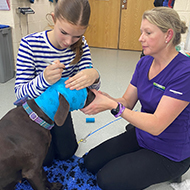Dr Charlotte Maile and Professor Richard Piercy.
RVC study reveals mechanisms that underlie form of 'tying-up'
New research has revealed the molecular mechanisms that underlie a common form of ‘tying-up’ in horses.
Tying-up, scientifically known as Type 1 Polysaccharide Storage Myopathy (PSSM1), is a common condition that damages equine muscle tissue.
Animals affected by the condition have a mutation of a key enzyme (glycogen synthase) which is involved in energy metabolism in muscle.
They also suffer from a build-up of polysaccharide (a form of carbohydrate) and increased storage of glycogen. Horses that carry the condition are prone to ‘tying up and muscle weakness.
Until now, nobody knew the precise mechanism by which the mutation caused increased enzyme activity in muscles. But new research, published in the journal Biochim Biohys Acta, shows that the mutation leads to a change in the enzyme’s structure, leaving it permanently active.
This hyperactivity, the team explains, accounts for the increased muscle glycogen and the accumulation of polysaccharide.
Led by Dr Charlotte Maile and Professor Richard Piercy of the RVC, the research was conducted by an international team of scientists from the University of Copenhagen, University of Minnesota, Indiana University School of Medicine and Liverpool John Moore’s University.
It is hoped that the breakthrough will enable the team to work towards improving treatments and management for this disorder, to improve the welfare of affected horses.
"PSSM1 is a very common disease, especially in some breeds. Finally we know the reason why these horses store excessive glycogen and polysaccharide in their muscles. Our goal now is to use this information in designing new treatments and management strategies,” said Professor Richard Piercy, Professor of Comparative Neuromuscular Disease.
Prof Richard Piercy added: “Managing horses that tie-up is hard, and some recommended treatments work poorly in some animals. By revealing the precise mechanism for this form of tying up, our work should make a real difference.
“Our hope is that by targeting specific approaches to the problem, rather than a ‘one treatment fits all’ - horse welfare will be improved allowing them to get back to exercise, which has to be good for the horse and their owner”.








